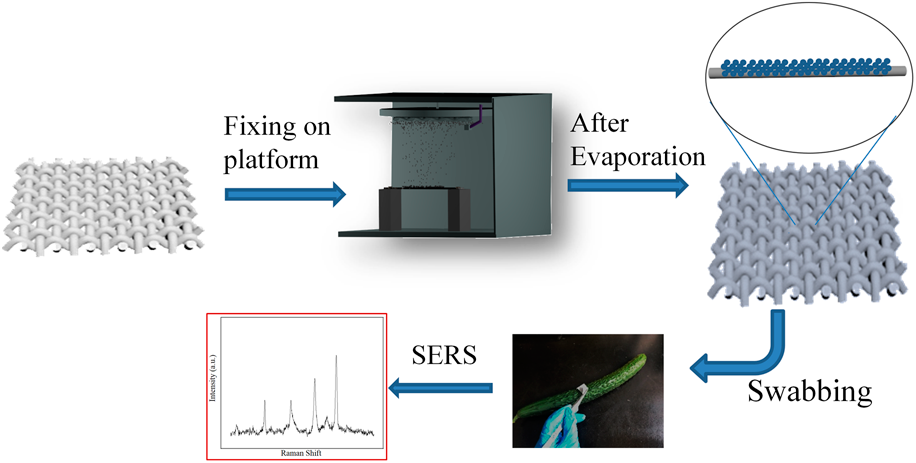Crossref Citations
This article has been cited by the following publications. This list is generated based on data provided by
Crossref.
Wu, Wenjie
Li, Rui
Chen, Maodu
Li, Jiankang
Zhan, Weishen
Jing, Zhenguo
and
Pang, Lu
2021.
Noble Metallic Pyramidal Substrate for Surface-Enhanced Raman Scattering Detection of Plasmid DNA Based on Template Stripping Method.
Micromachines,
Vol. 12,
Issue. 8,
p.
923.
Bharati, Moram Sree Satya
and
Soma, Venugopal Rao
2021.
Flexible SERS substrates for hazardous materials detection: recent advances.
Opto-Electronic Advances,
Vol. 4,
Issue. 11,
p.
210048.
Puchowicz, Dorota
and
Cieslak, Malgorzata
2022.
Recent Developments in Atomic Force Microscopy and Raman Spectroscopy for Materials Characterization.
Chen, Qi
Yuan, Dong
Wang, ZhuQing
Tang, LianBo
and
Feng, YangRun
2022.
Fabric-based in situ synthesis of gold nanoparticles for continuous enhanced heterogeneous chemiluminescence online detection of carbon dioxide.
The Analyst,
Vol. 147,
Issue. 17,
p.
3908.
Zhang, Shuo
Liu, Airong
Wang, Juan
Ge, Fengyan
and
Zhu, Quan
2022.
Recyclable SERS Substrate with Coral-like Nano Ag/ZnO Structure Based on Cotton Fabric Used for In-situ Detection of Pesticides.
Fibers and Polymers,
Vol. 23,
Issue. 3,
p.
636.
Sun, Chao
Zhang, Shuo
Wang, Juan
and
Ge, Fengyan
2022.
Enhancement of SERS performance using hydrophobic or superhydrophobic cotton fabrics.
Surfaces and Interfaces,
Vol. 28,
Issue. ,
p.
101616.
Shariat, Mahdi
2023.
Plasma jet printing of silver nanoparticles on polyester fabric as a surface-enhanced Raman scattering substrate.
Optik,
Vol. 277,
Issue. ,
p.
170698.
Wu, Fan
Li, Minghao
Liu, Tong
Cheng, Lin
Gu, Tongkai
and
Fan, Wei
2023.
Construction of dense plasmonic hotspots on coarse Ag layer coated nylon fibers for ultrasensitive SERS sensing.
Textile Research Journal,
Vol. 93,
Issue. 3-4,
p.
664.
Valderrama-Herrera, Miguel
Cardenas, Sara Amada
Calvo-Mac, Carlos
Celi-Vértiz, Renzo Gustavo
Chumpitaz-Levano, Valeria Liz
Flores-Miranda, Walter Eduardo
Lopez-Tirado, Zoila M.T.
Molina-Alvarez, Mariana
Rubio-Cheon, Diana N.
Trucios-Castro, Maryalejandra
Fernández Severini, Melisa D.
Forero López, Ana D.
Ramos, Williams
Pretell, Victor
Castro, Italo B.
Ribeiro, Victor Vasques
Dobaradaran, Sina
Espinoza-Morriberón, Dante
Ben-Haddad, Mohamed
Dioses-Salinas, Diana Carolina
and
De-la-Torre, Gabriel Enrique
2023.
Rajids ovipositing on marine litter: A potential threat to their survival.
Marine Pollution Bulletin,
Vol. 191,
Issue. ,
p.
114941.
Satani, Sampath Kumar
Moram, Sree Satya Bharati
and
Soma, Venugopal Rao
2023.
Gold nanostars loaded fabrics as flexible, low-cost SERS substrates and swab-based detection of thiram on fruits and vegetables.
Journal of Physics D: Applied Physics,
Vol. 56,
Issue. 37,
p.
375103.
Li, Na
Xu, Gengsheng
Yan, Manqing
Chen, Bensong
Yuan, Yupeng
and
Zhu, Chuhong
2023.
Fabrication of Vertically Aligned ZnO Nanorods Modified with Dense Silver Nanoparticles as Effective SERS Substrates.
Chemosensors,
Vol. 11,
Issue. 4,
p.
210.
Wang, Su-Yan
Shi, Xin-Chi
He, Feng
Zhu, Su-Qin
Chen, Xin
Herrera-Balandrano, Daniela D.
Liu, Feng-Quan
and
Laborda, Pedro
2024.
Recent advances in the use of surface-enhanced Raman spectroscopy for thiram detection in food products.
Journal of Food Composition and Analysis,
Vol. 136,
Issue. ,
p.
106855.
Wang, Peng
Jin, Zengkai
Mai, Ke
Zhu, Lei
and
Lin, Junxiong
2024.
Wearability Analysis of Ag Nanoparticle-Loaded Cotton Fabric Modified by SPEEK/PVA Blend Polymer.
Fibers and Polymers,
Vol. 25,
Issue. 6,
p.
2131.
Sharma, Keshav
Singh, Renuka
Sharma, Surbhi
Tripathi, Chandra Shekhar Pati
and
Guin, Debanjan
2024.
Nano-engineered polyester fabric based on silver nanoparticles loaded L-lysine-grafted graphene oxide for catalytic degradation and SERS detection of industrial pollutants.
Colloids and Surfaces A: Physicochemical and Engineering Aspects,
Vol. 686,
Issue. ,
p.
133332.
Zhan, Xiongwei
Zhang, Shuo
Du, Peibo
Wen, Yan
Wang, Juan
Cai, Zaisheng
and
Ge, Fengyan
2024.
Optimization of cotton SERS substrates based on different weave structures for surface trace detection.
Optical Materials,
Vol. 150,
Issue. ,
p.
115338.



